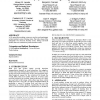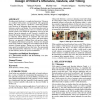HRI
2009
ACM
14 years 6 months ago
2009
ACM
This poster describes a robot cell-phone named CALLY with which we are exploring the roles of facial and gestural expressions of robotic products in the human computer interaction...
HRI
2009
ACM
14 years 6 months ago
2009
ACM
A 3D optical flow tracking system was used to track participants as they watched a series of boring videos. The video stream of the participants was rated for boredom events. Rati...
HRI
2009
ACM
14 years 6 months ago
2009
ACM
Providing route directions is a complicated interaction. Utterances are combined with gestures and pronounced with appropriate timing. This study proposes a model for a robot that...
HRI
2009
ACM
14 years 6 months ago
2009
ACM
HRI
2009
ACM
14 years 6 months ago
2009
ACM
During conversations, speakers establish their and others’ participant roles (who participates in the conversation and in what capacity)—or “footing” as termed by Goffman�...
HRI
2009
ACM
14 years 6 months ago
2009
ACM
Autonomous robots tend to induce the perception of a personality through their behavior and appearance. It has been suggested that the personality of a robot can be used as a desi...
HRI
2009
ACM
14 years 6 months ago
2009
ACM
Several emerging computer devices read bio-electrical signals (e.g., electro-corticographic signals, skin biopotential or facial muscle tension) and translate them into computer- ...
HRI
2009
ACM
14 years 6 months ago
2009
ACM
The concept of the huggable robot Probo is a result of the desire to improve the living conditions of children in hospital environment. These children need distraction and lots of...
HRI
2009
ACM
14 years 6 months ago
2009
ACM
We describe recent work on PECAS, an architecture for intelligent robotics that supports multi-modal interaction. Categories and Subject Descriptors I.2.8 [Computing Methodologies...
HRI
2009
ACM
14 years 6 months ago
2009
ACM
The Wizard of Oz experiment method has a long tradition of acceptance and use within the field of human-robot interaction. The community has traditionally downplayed the importanc...





